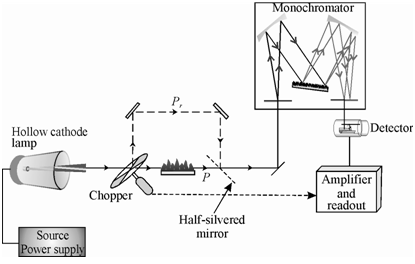Double Beam Atomic Absorption Spectrophotometer:
In this instrument the beam from the HCL is split through a mirrored chopper, one half passing by the atomiser and the other half around it, as schematically displays in Figure. The two beams are then recombined through a half-silvered mirror and passed by the monochromator. The ratio among the reference and sample signal is then amplified and fed to the readout show and recorder. These instruments correct the fluctuations within the intensity of radiation coming from the radiation source and for changes within the sensitivity of the detector. It must be remember that reference beam within double beam instruments does not pass by the flame and thus corrects for the loss of radiant power because of absorption or scattering through the flame itself.

Figure: Schematic diagram of a double beam atomic absorption spectrophotometer
Changes in peak shape or position could be indicative of interference problems. Most instruments are equipped along with a device for background correction. These days' concurrent multielemental atomic absorption spectrophotometers along with line source for 2 to 10 components have become available. The most successful design of a concurrent multielement AAS is based on continuum source and a multichannel straight reading spectrophotometer.